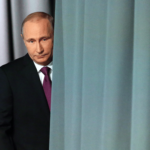Bolshoi ballerina Olga Smirnova, an international ballet star who recently publicly denounced the Russian invasion of Ukraine, has quit the famed Moscow ballet company and joined the Dutch National Ballet, the Amsterdam organization announced Wednesday.
“The whole company is thrilled and energized,” Artistic Director Ted Brandsen said Wednesday by phone from Amsterdam. “She’s a beautiful artist and a beautiful person. There’s something really magical about her; she dances with her entire soul. So to have her join our company is wonderful – even though the situation behind it is so tragic and so awful.”
In a brave but risky move, Smirnova had condemned the war in Ukraine last week in a post on the messaging platform Telegram, which is popular overseas.
“We cannot remain indifferent to this global catastrophe,” Smirnova wrote.
Video: Mother and son are reunited after Russian strike burns building
“I never thought I would be ashamed of Russia,” the ballerina continued in her post. She described herself as one-quarter Ukrainian, with a Ukrainian grandfather. Yet this alone did not drive her decision, she wrote: “It is that we continue to live as if this were the 20th century.”
“Now I feel that a line has been drawn that separates the before and the after. It hurts that people are dying, that people are losing the roofs over their heads or are forced to abandon their homes.”
Brandsen said Smirnova got in touch through a mutual friend to ask about joining his company. He said he has admired her for years, mostly from a distance, since she caught his eye at her graduation performance from the renowned Vaganova Academy in St. Petersburg. (Smirnova was unavailable for comment Wednesday.)
He has also welcomed a former Mariinsky dancer, Victor Caixeta, from Brazil, who left Russia in protest as well. According to Brandsen, Caixeta left the Mariinsky along with the company’s first English principal dancer, Xander Parish. Parish announced his departure from the Mariinsky on Instagram last week, saying he was leaving Russia “at least until peace comes. My heart goes out to the people of Ukraine.”
The war is having a huge impact on the international ballet community, where Russian and Ukrainian dancers are widespread thanks to the prominence of ballet in both countries, and the art form’s centuries-old roots there. Facing a tide of urgent requests, Brandsen has hired three Ukrainian dancers so far, two of whom have already arrived, and his organization is raising money to take in more. “We have more applications than we could possibly honor,” he said with palpable regret.
Additionally, the Dutch National Ballet Academy, the company’s training ground, has accepted seven students from Ukraine, and the school has found homes for them with Dutch families.
The war has had devastating effects on the large numbers of expatriate Russian and Ukrainian dancers pursing ballet careers around the globe, as Brandsen has seen among longtime members of his company.
“It’s been a really tough few weeks,” he said. “We have Ukrainian dancers whose parents are hiding in bomb shelters.” One 12-year veteran of his company has family in Kharkiv, which has come under heavy Russian bombardment.
“She managed to get her mother out and she’s arrived here,” Brandsen said. “But her brother and father can’t leave because they’re needed to fight.
“Everyone in the whole ballet world is trying to do what they can,” he added. “I can’t offer jobs to everyone, but I can offer classes and training for dancers who are hoping to train while looking for jobs somewhere else.” Ukrainian dancers who live in Russia have also been reaching out, and Brandsen said he is “trying to send them on to other countries where we have connections.”
As for Smirnova, she began rehearsals Wednesday and will dance in Amsterdam starting on April 3, in the classic Russian ballet “Raymonda.” Her opening night is already sold out.
Related Content
Desperate Ukrainians search for missing relatives in Mariupol
Zelensky puts Biden on the spot with his emotional speech to Congress
It began as a tool to save wild elk. A century later, feeding threatens iconic herds.




